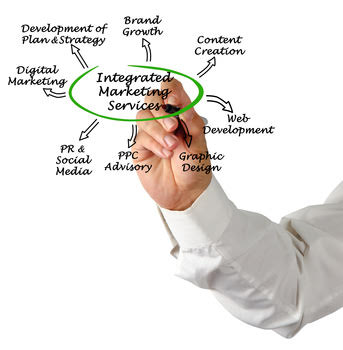
If you’re marketing for B2B today, you know that one tactic alone won’t be the silver bullet. It’s the collection of all campaigns and tactics working together.
Successful integrated marketing strategy starts with a committed brand focus, including a differentiated position, a compelling messaging platform with unique messages to critical audiences, and a savvy integrated marketing plan that connects all touch points that could influence and persuade buyers.
Rethinking integrated marketing in an expanding digital world
Now, the voice of the brand can speak to every target, through every relevant discipline (advertising, public relations, promotion, marketing literature, sales force presentations, outdoor, event marketing, design, etc.) at every touch point. It is driven by a singular brand idea, not an advertising concept.
It’s not just advertising execution, which is homogenized and rolled out to be translated to other platforms. Each discipline draws from its own strengths.
- Social media generates buzz, and enables wide conversations.
- Email lets you explain an idea, with lots of clickable links to different content assets
- Embedded Video is becoming the preferred medium for product and service introductions; people love to learn visually.
- Rich content (Surveys, studies, white papers, slide decks) educates, informs, and build brand loyalty
- Webinars give you the opportunity to drive home sales messaging in a group learning environment.
Turning the Buyer’s Journey into an ongoing, interconnected relationship
You can build a recurring path for your buyer’s journey by connecting multiple platforms that continue to inform, educate and intrigue. All touch points should feed each other, and become connected in a web of conversation.
- A print or online ad with a URL can lead to a microsite where a corporate buyer can download a white paper or watch a YouTube video.
- An outdoor ad can invite corporate prospects to scan a QR code with their mobile device and take them to a microsite with more information.
The Paid, Owned, Earned mix and how they work together
There are lots of ways to tell your brand’s story; the trick is coordinating them into a theme that generates leads and helps to close sales.
Traditional PR involves press releases, working media contacts, and promoting your company’s brand as an influential authority within its industry. Phones, press kits, rollout events and emails were the standard tools of the trade.
PR still has a role in modern integrated marketing, even if some of the tools have changed. You use Twitter now to reach most journalists, but earned media on TV, radio or podcasts is still golden, and serves as another opportunity to spread a consistent brand message.
Social Media Marketing (SMM) can be considered a PR function these days. Posts (including sponsored post) on Twitter, Linked In or Facebook give your company a personality and a face to present to the world.
Digital and mobile advertising, such as SMS, can also serve your integrated strategy when you use a consistent theme, but tailor each message appropriately to its medium.
Suggestions for feeding your Content machine
The most important commitment is to keep the creative pipeline flowing, from tweets to white papers, and all that lies between.
Many firms create a core marketing asset to leverage, such as a survey or study. They can be used in PR campaigns as well as advertising and social sharing campaigns.
Create a story from data about your industry to engage customers (see the first campaign example, below).
Noteworthy examples of successful integrated marketing campaigns for B2B
Intermedia: Cloud IT Company’s “Shocking Data” Strategy
Using one of the aforementioned core marketing assets, a study of office workers’ data security habits, Intermedia developed a clear and compelling marketing angle centered on a key insight from the report. Marketing outreach focused on certain data angles, with a heavy emphasis on the most shocking findings.
A single message was used to target region- and industry-specific vertical markets with press pitches, a live-action video, snackable infographics, email marketing, and more.
Results: Generated hundreds of new leads, nurtured existing leads, created social buzz with embedded video and links, and enabled salespeople and channel partners to create consultation and selling opportunities as one cohesive team.
Cision: Influencer Content for Audience Skill Building
As the PR industry has been changing in recent years, the PR media services firm Cision saw an opportunity with an influencer to co-create content that benefited both parties. The company partnered with Brian Solis of Altimeter Group to develop an eBook on Slideshare that was used both as a tool for a PR audience looking to build tech skills, and for a key part of Solis’ own presentations.
Results: 209,673 views on Slideshare, plus the content was shared by 11 Twitter influencers that reached a combined audience of 2 million. The content also generated 600 sales leads.
What’s your level of readiness for a modern integrated marketing strategy?
- To design – or beef up – an integrated strategy that encompasses real-time multimedia, audience engagement, you need to first assess your current mix of traditional, outbound and inbound content strategies.
- How much of which kinds are you doing today – and how good or bad are the measured results?
- Are you using metrics aggregated from each source, to know if what you’re doing is working?
- Identify stakeholders – Your CMO, Sales, outside media buyers or ad agencies, and the capabilities of any digital strategists on your team to implement your integrated strategy.
- Are there influencers, forums or “brand ambassador” audiences who could further your message through social media or other mobile or digital channels you haven’t used in the past?
Once you’ve thought through all of these and they seem aligned, then you’re ready for the next stage: campaign planning.
The Campaign Stack is an organizational tool for communications planning. In it, you lay out every channel in your integrated campaign that will carry key messages.
Include both internal and external communications. Don’t forget to help employees be brand ambassadors by showing them how their work directly helps customers! An internal video is a great way to show them the value of what they do, for customers and for the company itself.
A professional digital marketing agency can help you assess your readiness and capacity to conduct an integrated marketing strategy, as well as recommend the best strategies for your particular business and industry. If you love the idea but need a little professional help, contact Leadit Marketing today.

Shannon Prager is recognized B2B marketing strategist and the President of Leadit Marketing. She is responsible for the daily operations and management of Leadit Marketing as well as the long term vision for the company.
A marketing leader with over 19 years of B2B demand generation and marketing experience, she understands the importance of a fully developed integrated marketing strategy. Shannon’s background includes demand generation, marketing automation, social media, digital marketing, customer marketing, account based marketing and marketing operations. You can follow her on LinkedIn via Shannon Prager or Twitter @ https://twitter.com/LeaditMarketing
